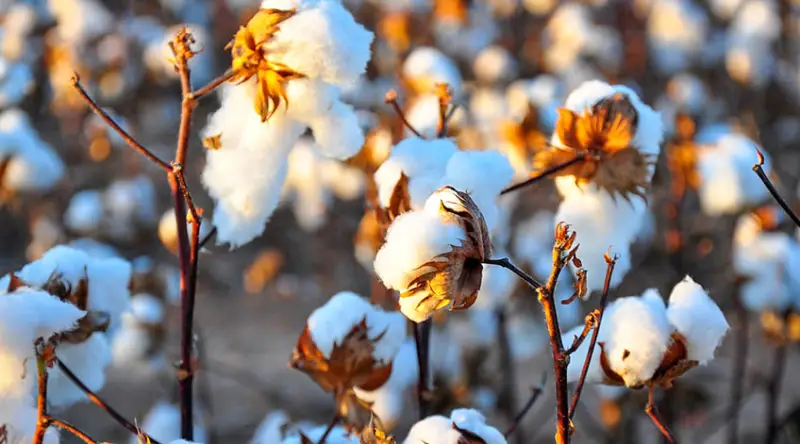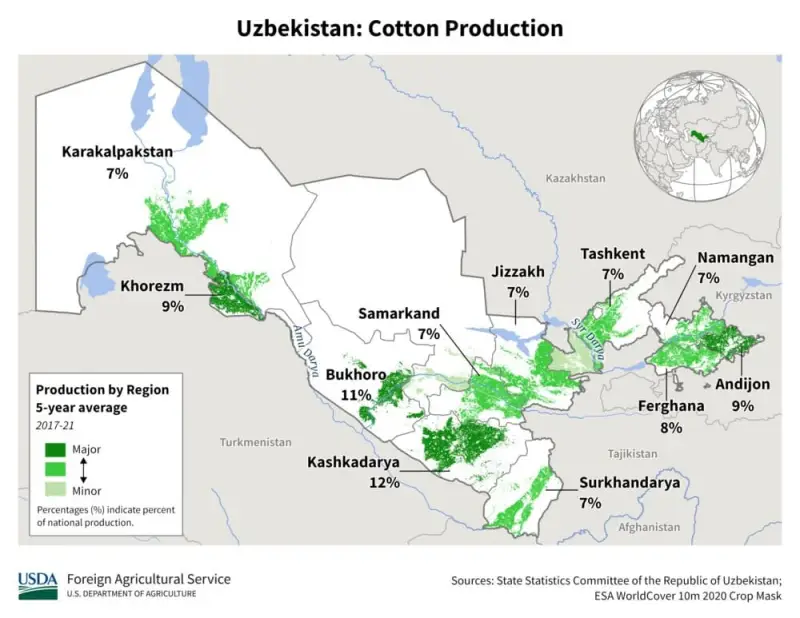Was there cotton? The heavy Soviet legacy of the Russian light industry

Russia has never been a cotton power. Flax, hemp, even silk thread - this is all right, but “our” cotton was only found in Central Asia. And if in the USSR the problem of raw material supply for textile production was solved one way or another, over the past decades it has only grown.
During the international exhibition “Interfabric-2024”, which recently ended in Moscow. Spring,” President of the Russian Soyuzlegprom Andrey Razbrodin said that “Russia is still 100% dependent on cotton imports. After the collapse of the USSR, Russia was left simply without a cotton raw material base.”
At the industry forum, many officials complained about the same thing, recalling that since the mid-19th century, Russian textiles have been focused mainly on the use of Central Asian raw materials.
Cotton crops in Southern Russia
However, few people remembered that “in southern Russia, including Crimea and the Lower Volga region, in Moldova, in southwestern Ukraine and Armenia in the 1930–1950s there were significant cotton crops; varieties have been developed suitable for cultivation and processing in this vast area.”
These are lines from the 2015–2016 study. All-Russian Research Institute of Irrigated Vegetable and Melon Growing (Astrakhan Region). Productivity was often 20-30% lower than in Central Asia, but this raw material was used in general at a third of the light industry capacity of the European region of the USSR and Transcaucasia.
It turns out that during the “difficult” Soviet years, such a vast region was less dependent on Central Asian supplies than in the subsequent and post-Soviet periods. At the same time, Azerbaijani cotton was increasingly used.
But, as Astrakhan scientists point out, “About the mid-60s, cotton growing in these regions, except for Azerbaijan, was declared unprofitable. Breeding institutions were repurposed, cotton gins and related factories were dismantled and transported to Central Asia.
Although in the same regions of the RSFSR-RF there are still natural conditions for the restoration and development of cotton growing. This is shown by scientific developments and experimental cotton farms created in the late 90s – early 2000s in the Lower Volga, Stavropol, Dagestan, and Kalmykia.”
However, this direction still remains experimental. Perhaps the main reason for the current situation was, again, the directive, but widespread cultivation of corn, including in the mentioned regions. Because of this, the area of flax and industrial hemp in the USSR also decreased by more than two-thirds.
It was flax and hemp that for many decades accounted for up to 40% of the raw material supply of the Soviet textile and light industry. Including in the RSFSR - at least 60%. Widespread cultivation of corn ceased by the end of the 60s, but the restoration of areas under cotton, flax and industrial hemp never took place.

Due to degradation - due to maximum chemical replenishment - and natural depletion of former “corn” soils, aging of specialized equipment, growing shortage of personnel and seed fund. The same factors still influence flax and hemp production in the Russian Federation: the current area under these crops and their yield is 4–5 times less than in the second half of the 60s.
Moscow's cotton policy
In the 50s and early 60s, the USSR imported cotton and cotton yarn mainly from China at low prices and through barter. But the subsequent deterioration of Soviet-Chinese relations stopped supplies that were so beneficial to the USSR. And purchases abroad, including China, were carried out, as a rule, in foreign currency.
At the same time, it becomes more expensive every year. In addition, the cultivation of cotton in Hungary, Romania and almost completely in Bulgaria ceased by directive - synchronously with the USSR. Where, we note, varieties from the European region of the USSR and Azerbaijan were cultivated, not without success, in the late 40s and early 60s.
Accordingly, from the mid-60s, a bet was made on the record development of cotton growing in Central Asia. But with the massive use of chemicals; flawed but cheap soil technologies; with depletion and pollution of local water resources; with the annual reduction of areas under other agricultural crops and pastures there in favor of cotton.
In addition, in this area, de facto slave labor was used - serf labor of tens of thousands of local residents: from schoolchildren to doctors of science. This further reduced the cost of local cotton growing. And it is by no means a fact that such labor in cotton growing has been completely eliminated in post-Soviet Central Asia.
In any case, it was only in the early 2020s that the United States lifted restrictions on the import of cotton and cotton products from Turkmenistan and Uzbekistan, introduced in the early 2000s due to the use of child labor in the cotton growing of these countries.
Moscow’s cotton policy stimulated anti-Soviet as well as Russophobic sentiments in a vast region. And the Aral disaster, with obvious environmental, social, and then political consequences, was directly caused by the rapidly growing water consumption in cotton growing.

Cotton was exported to the RSFSR raw, and the local processing base was failing. It is no coincidence that by the end of the USSR, anti-Soviet and Russophobic aspirations and corresponding personnel had already prevailed in the leadership of the Central Asian republics. Along the way, a whole system of “cotton” fraud and “cotton” corruption grew in the region, especially in Uzbekistan.
For currency
Since the beginning of the 90s, Central Asian cotton began to be supplied to the Russian Federation purely for foreign currency. And after 10–15 years, all the “cotton” countries in the region announced the cessation of cotton exports and the reduction of cotton areas in favor of other agricultural crops.
Now Russia has to purchase these raw materials in other countries, including China, for foreign currency (many times smaller quantities are still supplied for foreign currency from Central Asia).
There were opportunities and projects for the barter development of cotton growing in Afghanistan (until the early 80s), Egypt (until the mid-70s), Somalia (until 1978), friendly to the USSR, Cuba, Bulgaria, Algeria, Syria, Libya, Ethiopia, Iraq, North and South Yemen.
Moreover, mainly through commodity barter, these raw materials, although in small volumes, were previously supplied from there to the USSR. But the costs of Soviet assistance to this industry in these countries, sea freight and subsequent delivery of large volumes from these countries to Russian enterprises were disproportionately higher than the costs of supplies from Central Asia.
Information